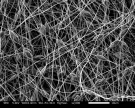Electrospinning Method
Major features of the electrospinning method is to spin a variety of materials (mainly polymers) into nanofiber shapes and control of fiber shapes is relatively easy.
Research up to now realized electrospinning of the following materials.
(See Fig.1)
- Industrial thermoplastic polymer
- Biodegradable polymer
- Polymer blend
- Composite materials mixed with inorganic compounds

Fig.1 Principles of electrospinning
In recent years spinning cases of the ceramic nanofibers such as Alumina, Zirconium oxide, Titanium oxide and Lead zirconate titanate are reported frequently.
Electrospinning method usually uses solutions in which materials dissolve in solvents as spinning materials.
Electrospinning system, as shown in Fig. 1, consists of a high voltage power supply, polymer solutions, a storage tank, a spinneret and a grounded collector. Polymer solutions will be pushed out of a tank to a spinneret at a constant speed.
High voltage at 20kV to 40kV will be applied to a spinneret and polymer solution jet will be injected to a collector when electrical attraction exceeds surface tension of polymer solutions. Solvents in jets are gradually volatilized and jets will reduce to nanometer level when they reach a collector.

Fig. 2
Electrospun nanofibers forms membranes shown in Fig. 2. Orientations of fibers depend on a collector.Nanofiber membranes are known that its total surface area per volume is much more than that of micrometer-size fiber membranes.

Beaded fiber

Aligned fiber

Nanoflament
Fig. 3
As a result, nanofibers obtain unprecedented characteristics by having chemical or physical modifications, and new applications in various fields are expected.
As shown in Fig. 3, even if the same polymer is spun, fibers in different shapes, such as smooth-surface fibers, beaded fibers and porous fibers, can be made by changing spinning parameters.
Parameters in terms of electrospinning are generally divided into three groups of solution characteristics, spinning environment and spinning conditions. (Fig. 4)
・Solution concentration
・Viscocity
・Conductivity
・Elasticity
・Surface tension
・Ambience temperature
・Humidity
・Barometric pressure
・Voltage to apply
・Solution discharge amount
・Distance between collector and spinneret
・Winding speed of a collector
Fig. 4 Parameters of electrospinning method to influence shapes of nanofibers.
 How to combine such parameters will be “knowhow.” It is most difficult to find out the best spinning conditions to obtain desired shape of nanofibers, which usually takes a long time period.
How to combine such parameters will be “knowhow.” It is most difficult to find out the best spinning conditions to obtain desired shape of nanofibers, which usually takes a long time period.
So much time has been taken by many people to figure out relevancy between such parameters and shapes of fibers, however, it is becoming clearer in these days.
Polymer concentration of spinning solution is obviously the most important factor to control diameters of polymer fibers. Also, design of a collector will be important to control orientation of fibers.
Aligned nanofiber samples made with a disk collector is shown in Fig. 5. There are several important parameters to be controlled such as fiber diameters, surface shapes and orientations.
